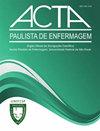医院手术部位感染预防措施的依从性
IF 1
4区 医学
Q3 NURSING
引用次数: 0
摘要
目的:评估根据世界卫生组织提出的建议在临床实践中采取的手术部位感染预防和控制措施的合规性:审计抗生素给药时机、用电动剪/一次性刀片进行三分切开术、材料无菌确认、,以及手术部位感染率的监测和传播。方法:这是一项横断面观察性研究,于2018年2月至2019年4月在米纳斯吉拉斯州的30家医院进行,基于对外科手术的审计、情境诊断和医院感染控制服务的访谈,报告了预防性抗生素使用和依从性审计的方案,69%报告了用电动剪子进行的三分切除术。所有患者均进行了手术部位感染监测,但只有63.3%的患者进行了感染率披露。在情景诊断中,76.7%的患者在手术室内用电动剪子进行了三分之一切开术(56.7%)。在手术切口前30-60分钟的抗菌药物给药时间审计中,63.3%的患者符合要求;93.3%的服务通过工艺指标确认材料无菌。结论:医院感染控制服务的建议与在情景诊断和手术程序审计过程中遵守良好做法之间存在差异,这加强了培训和审计的必要性,旨在有效遵守专业人员关于此类措施的做法。本文章由计算机程序翻译,如有差异,请以英文原文为准。
Compliance with surgical site infection prevention measures in hospitals
Objective: To assess compliance with actions for surgical site infection prevention and control, adopted in clinical practice in accordance with the recommendations proposed by the World Health Organization: auditing the moment of antibiotic administration, trichotomy with an electric clipper/disposable blade, material sterility confirmation, and surveillance and dissemination of surgical site infection rates.
Methods: This is a cross-sectional observational study, carried out in 30 hospitals in the state of Minas Gerais, from February 2018 to April 2019, based on an audit of a surgical procedure, situational diagnosis and interview with Hospital Infection Control Services.
Results
In 93.3% of Hospital Infection Control Services, protocols for prophylactic antibiotic use and compliance audits were reported, 69% reported trichotomy with an electric clipper. All carried out surgical site infection surveillance, however, only 63.3% carried out rate disclosure. In the situational diagnosis, trichotomy was performed in 76.7% inside the operating room with an electric clipper (56.7%). In the audit of the moment of antimicrobial administration between 30-60 minutes before surgical incision, compliance was identified in 63.3%; 93.3% of services confirmed material sterility through process indicators.
Conclusion: Differences were found between recommendations from the Hospital Infection Control Service and compliance with good practices during situational diagnosis and auditing of surgical procedures, reinforcing the need for training and audits aimed at effectively complying with professionals’ practices regarding such measures.
求助全文
通过发布文献求助,成功后即可免费获取论文全文。
去求助
来源期刊

Acta Paulista De Enfermagem
NURSING-
CiteScore
1.40
自引率
0.00%
发文量
92
审稿时长
4 weeks
期刊介绍:
Acta Paulista de Enfermagem – (Acta Paul Enferm.), ISSN 1982-0194, is a [bilingual] technical-scientific electronic publication of the Escola Paulista de Enfermagem – EPE, Universidade Federal de São Paulo – UNIFESP.
Our mission: To disseminate the scientific knowledge generated within the rigor of research and ethics methodology.
Our objective: To publish results of original research for advancement of practices of clinical, surgical, and management nursing, as well as education, research, and information and communication technology.
 求助内容:
求助内容: 应助结果提醒方式:
应助结果提醒方式:


